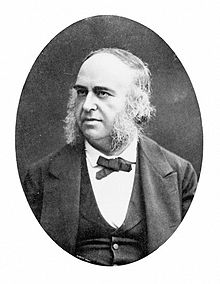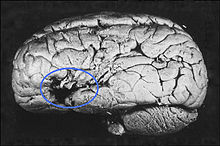- Paul Broca
-
Pierre Paul Broca (* 28. Juni 1824 in Sainte-Foy-la-Grande bei Bergerac; † 9. Juli 1880 in Paris) war ein französischer Anthropologe und Arzt. Nach ihm wurde die Broca-Aphasie (Fall des „Monsieur Tan“) und das Broca-Zentrum benannt. Er beschrieb 1861 erstmals einen limbischen Lappen, heute als Limbisches System bezeichnet.
Das Broca-Zentrum oder Broca-Areal ist im Gehirn an der motorischen Erzeugung von Sprache beteiligt, während das Wernicke-Areal (nach Carl Wernicke) an dem Verstehen von Sprache beteiligt ist.
Broca wird der inzwischen veraltete und fachlich abgelehnte Broca-Index zur Beurteilung von Gewichtsproblemen zugeschrieben.
Er ist namentlich auf dem Eiffelturm verewigt, siehe: Die 72 Namen auf dem Eiffelturm. Außerdem war er korrespondierendes Mitglied der Berliner Gesellschaft für Anthropologie, Ethnologie und Urgeschichte.
Der Fall „Monsieur Tan“
Um 1860 herum hatte Paul Broca einen Patienten namens Monsieur Tan. „Tan“ war die einzige Silbe, die der Patient noch sprechen konnte, obwohl das Sprachverständnis nicht beeinträchtigt zu sein schien, da er durchaus noch in der Lage war, ihm gestellte Fragen zu verstehen. Durch prosodische Artikulation verschiedener Betonungsmuster, Tonhöhen und Aneinanderreihungen dieser einen Silbe versuchte „Monsieur Tan“ die Fragen zu beantworten.
Die postmortale Autopsie ergab, dass das Gehirn von Monsieur Tan zwischen dem Frontallappen und dem Temporallappen eine Läsion aufwies. Broca folgerte daraus, dass diese Stelle maßgeblich an der Sprachproduktion beteiligt sein müsse. Seither gilt dieses Areal als der neurologische Ort, an dem Sprache entsteht.
Weblinks
- Kurzbiografie und digitale Quellen im Volltext (englisch) im Virtual Laboratory des Max-Planck-Instituts für Wissenschaftsgeschichte
Siehe auch:
Wikimedia Foundation.


